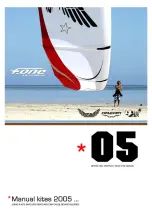
5
Construction of the canopy:
Rigging system:
The canopy of the ENVY 2 consists of 56 cells over the wingspan. The wingtips are
slightly pulled down and this produces a kind of stabilizer. The Envy 2 is a third rib
diagonal-construction paraglider. Every main main rib is attached to the 4 or 5
suspension lines. Between these main suspension ribs, intermediate ribs are
suspended by diagonal segments. These diagonal ribs lead to top surface of canopy.
This construction ensures a smooth top surface and precise airfoil reproduction. The
internal reinforcements maintain the precise form of the canopy and provide stability.
The cell openings on the under-surface of the profile's nose provide airflow into the
glider. Stretch resistant flares, integrated with diagonal ribs at the suspension points,
ensure an even distribution of load throughout the canopy. A stretch resistant Mylar strip
on the top and bottom panels alongside the openings and running the length of the
trailing edge defines the wingspan, together with an optimized sail tension; this
guarantees a high form stability. Large cross ports allow effective airflow inside the
canopy, providing good re-inflation without reducing the profile accuracy.
The Envy 2 is mainly made of the proven Nylon fabrics Porcher Marine Skytex Rip-stop
9092 E85A, 9017 E38A and 9017 E29A. Like any synthetic material, this can deteriorate
through excessive exposure to UV.
The lines of the Envy 2 are made of proven strong and stretch resistant Polyester HMA
Aramid/Kevlar (yellow core) lines and PES/Dynema (white core) lines. The entire rigging
system comprises individual suspension lines looped and stitched at each end. The
Aramid main lines have strengths from 140 up to 230 kg. The Aramid cascade lines have
strengths from 60kg up to 120 kg. The Dynema brake lines have strengths from 100kg
up to 240 kg.
The suspension lines are comprised of “cascaded top lines” (attached to the under-
surface),”cascaded middle lines” (cascade 2 to 2 top lines together on middle main
lines), and “main lines”. Main lines lead to the “quick link” (a Maillon which connects lines
and risers). The “stabilizer lines” connect the upper stabilizer lines on the outer
TECHNICAL DESCRIPTION
6
suspension points with the quick link. The”brake lines” are not load carrying suspension
lines. They lead from the trailing edge of the canopy to the main brake lines and run
through the pulleys on the D-risers to the brake handles. A mark on the main brake line
indicates the position of the brake handle. This adjustment, on the one hand, allows
sufficient brake to be applied during extreme flying situations and when landing, while on
the other hand, this ensures that brakes are not permanently applied to the canopy
(especially when fully accelerated). This trimming should not be altered. For
differentiation purposes the A-lines are coloured red, the brake lines are orange, all
remaining lines are yellow. Also the main suspension loop, on the bottom of the riser, is
covered red. This is where the main karabiner should be hooked in, which then in turn
connects the risers to the harness.
The Envy 2 is equipped with 5 risers per side (A, A1, B, C, D). The two central A-lines per
side are attached to the main A-risers while outermost A main lines are attached to A1
risers. The 3 B-main lines and the stabilizer lines are attached to the B-riser. The 3 C-
main lines to the C-riser. The 3 D-main lines to the D-riser. The main brake lines leads
through the pulleys on the D riser.
The line connections are made to triangular Maillons (quick links) fitted with a rubber
”o- ring” in the form of a ”figure eight” which prevents any slipping of the lines on the quick
link.
See line plan for details.
The Envy 2 is equipped with a stirrup operated speed-system, which returns
automatically to normal position when the stirrup is released. The serial risers of the
Envy 2 do not have a lockable trimmer.
The speed system affects the A-, A1-, B- and C-risers and changes the angle of attack. In
normal flight all risers have an overall length of 50 cm without quick links. When the
stirrup is pushed out the A-risers are shortened by up to a maximum of 15 cm, the A1-
risers are shortened by up to a max of 15 cm, the B-risers by up to a max. of 10 cm, the C-
risers by up to a max. of 5,5 cm, the D-risers retain their original length. These
measurements influence the certification! An incorrectly fitted speed system causes loss
of certification!
Most modern harnesses have pulleys attached for speed system fitting. In case not, it is
important to attach pulleys (sewn on tabs) in such a way that they allows the pilot to
maximize the power vector of his / her legs without ”pushing back” in the harness.
The Envy 2 speed system, including Brummel-hooks supplied, must be assembled as
per instructions.
The speed system cord is firmly attached (use bowline or other nonslip knot) to the foot
stirrup (webbing or alloy bar). The other end of the cord is run through a pulley on the
harness and then in an upward direction to be then firmly attached to the Brummel-
hooks!
Speed system:
Fitting the speed-system:


































